Lipopeptides: A Distinct Class of Antibiotics with Diverse Applications
Meena RK, Abhishek S and Kanwar SS*
Department of Biotechnology, Himachal Pradesh University, India
Submission: September 19, 2017; Published: November 14, 2017
*Corresponding author: Kanwar SS, Department of Biotechnology, Himachal Pradesh University, India, Tel: 911772832153; Email: kanwarss2000@yahoo.com
How to cite this article: Meena RK, Abhishek S,Kanwar SS. Lipopeptides: A Distinct Class of Antibiotics with Diverse Applications. Adv Biotech & Micro. 2017; 7(2): 555706. DOI:10.19080/AIBM.2017.07.555706
Abstract
A number of novel microbial lipopeptide(s) have been reported over the alt few years for their potential therapeutic applications for human welfare. Bacterial lipopeptides are of 1.1 to 1.2kDa small lipidic peptides which have some specific/unique physicochemical and biochemical properties that make them successful for use by human beings. In the context of biological control, the three families of genus of Bacillus lipopeptides i.e. Surfactant, Iturins and Fengycins have been studied for their potent antagonistic activities against human as well as plant diseases. Iturins a composed of two major parts: a peptide part of 7 amino acid residues and a hydrophobic tail of 11-12 carbons. Surfactant (~1.036kDa) is an amphipathic cyclic lipopeptide consists of Glu-Leu-Leu-Val-Asp-Leu-Leu (ELLVDLL) interlinked with β-Hydroxy fatty acid chain of the length of 12 to 16 carbon atoms to form a cyclic ring of lactose. The Surfactant molecule presents a high resistance to heat, cold and satiric influences. Fengycins is a bioactive lipopeptide produced by several strains of Bacillus subtilis. It has antifungal activity against filamentous fungi. The lipopeptide bioactive molecules are mainly considered as potent alternatives to the current problem of resistance of pathogens to the conventional antibiotics, microbial infections and life-threatening diseases. Besides antibiotic applications, the LPs may be used in enhanced oil recovery, killing of cancer/ tumour cells and its possible application in loss of fat cells allowing anti-obesity treatment. Interestingly, the bacterial lipopeptides have lower toxicity for plants and animals, high biodegradability, low irritancy and good compatibility with human skin.
Keywords: Lipopeptides; Surfactant; Iturins; Fengycins; Structure; Applications
Introduction
Environment pollution, food scarcity and health concern are serious problems in the today’s scenario. Almost all the synthetic surfactants are toxic and not ecofriendly. They lead to adverse effects in the environment and also cause human skin health problems [1-3]. These chemical compounds extensively used in petroleum/oil industries are usually toxic, irritant and recalcitrant leading to disposal problems for oil field produced water, ground water contamination and ample health risks to humans [4]. Substantial use of chemicals to control plant/animal diseases has disturbed the ecological balance of microbes inhabiting soil leading to development of resistant strains of pathogens [5,6].
Cancer, a cell-proliferation disorder involving an obstruction to apoptosis, was one of the most frightened diseases of the 20th century and its continued spread with continuously increasing incidence has entered into the 21st century [7]. Apoptosis, which is a major method of programmed cell death, plays an important role in the regulation of tissue development and homeostasis [8].
The constant increasing drug resistance in the bacteria has elicited an urgent need to find out some other alternative lipopeptide-like molecules to be used for clinical and therapeutic applications as well as in food preservation and dairy products [9]. Demand of lipopeptides (LPs) is also surging by leaps and bounds due to their utility for the human welfare [6]. The published literature indicates that members of the genus Bacillus are considered as efficient natural microbial factories for the large scale production of such bioactive antibiotic molecules [10]. Due to diverse applications of lipopeptides, these antibiotics are considered as versatile weapon(s) to combat disease causing pathogenic organisms of the human beings. The three families of Bacillus lipopeptides i.e. Surfactins, Iturins and Fengycins have been studied for their vigorous antagonistic activities against various phytopathogens, too [11]. Polymyxin lipopeptide binds to lip polysaccharides by electrostatic interaction through its N-terminal fatty acryl tail and exhibits potent antibacterial activity [12]. Multiple applications of Surfactins make it an effective candidate drug for the resolution of a number of global issues in the field of medicine [13], industry [14] and in environmental protection [15]. Interestingly, the bacterial lipopeptides are also getting more attraction due to their lower toxicity for plants and animals, high biodegradability, low irritancy and compatibility with human skin [16,17].
Types of microbial lipopeptides
Lipopeptides are a unique class of relatively low molecular weight compounds, which lower the surface and interfacial tension more efficiently than other bio surfactants. Lipopeptides which are predominantly synthesized by Bacillus spp. have good heterogeneity in the type and sequence of the amino acid moieties as well as in the nature, length and branching of attached fatty acid chain and their moieties [18]. Lipopeptides are mainly classified into: Iturins, Surfactins and Fengycins bio surfactants. Broadly there are four types of LPs namely Surfactins, Iturins and Fengycins and Kurstakins produces by various organisms.
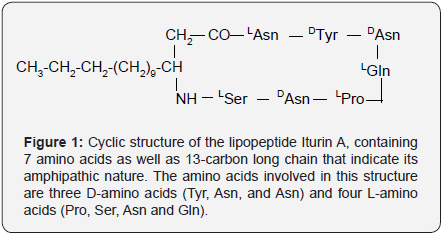
Iturins: Amongst the three types of lipopeptides, Iturins is the molecular mass of ~1.080kDa [19]. Iturin composed of two major parts: a peptide part of 7 amino acid residues and a hydrophobic tail of 11-12 carbons (Figure 1) this structure of Iturins A clearly indicates an amphiphilic character of this compound, thus pointing towards the cellular membranes as the most probable site of their action [20]. Iturin lipopeptide is a cyclic peptide of 7 amino acids (heptapeptide) linked to a fatty acid (β-amino) chain that can vary from C14 to C17 carbon molecules, exhibit strong in vitro antifungal activity through the formation of ion-conducting pores on fungal membranes [11]. They exhibit structural heterogeneity at the amino acid residues as well as in fatty acid chain length and branching.
Some examples of these amphiphilic compounds include Iturins A, C, D and E, Bacillomycins D, F and L, Bacillopeptin and Mycosubtilin, all of which are arranged in an amino acid configurationally sequence of LDDLLDL. Especially, Iturin A is composed of up to eight isomers (Iturin A1-A8) with different lengths (10-14 carbons) and branching (n, iso or anteiso configurations) of the fatty acid chain. These lipopeptide molecules are of appreciable interest because of their biological as well as physic-chemical properties, which can be exploited in food, oil and pharmaceutical industries. All strains of Bacillus subtilis produce lipopeptides of this family of Bacillus sp. Iturin operon is the size of 38-40kb and made up of four open reading frames namely ItuA, ItuB, ItuC and ItuD [21].
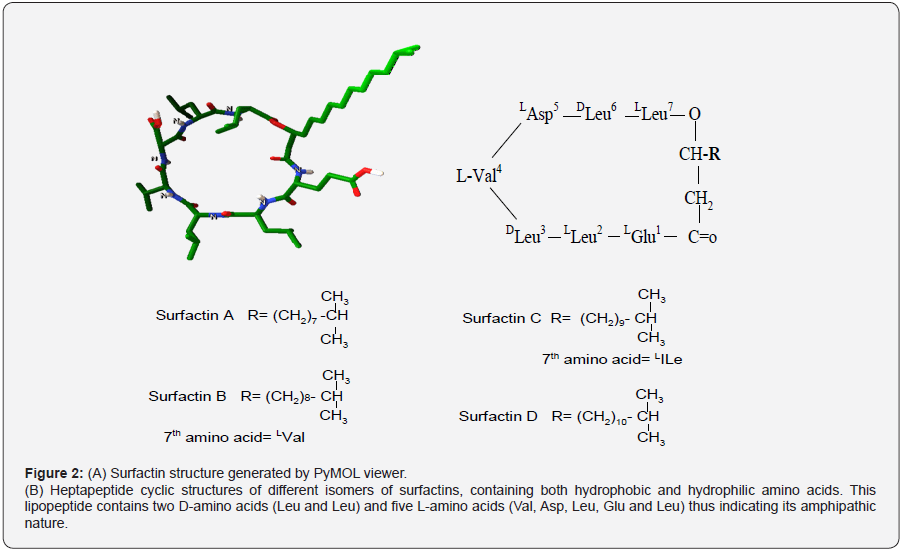
Surfactins: Surfactin (~1.036kDa), is an amphipathic cyclic lipopeptide consists of Glu-Leu-Leu-Val-Asp-Leu-Leu (ELLVDLL) interlinked with β-Hydroxy fatty acid chain of the length of 12 to 16 carbon atoms (Figure 2) to form a cyclic ring of lactose [22]. Same sequence of amino acids is also found in AMSH2O-1, a strain of Bacillus spp. well known for the lipopeptide production. The type of Surfactins varies according to the order of amino acids and the size of lipid portion present in the molecule [23]. Hydrophobic amino acids of the Surfactins molecule are located at 2, 3, 4, 6 and 7 positions from right from below in the cyclic structure while the Glu and Asp residues located at 1 and 5positions, respectively introduce two negative charges to the molecule. Usually, Surfactins isoforms coexist in the cell of a bacterium as a mixture of several peptidic variants with a different aliphatic fatty acid chain length. The pattern of amino acids and β-Hydroxy fatty acids in the Surfactins molecule depends not only on the producer bacterial strain but also on the type of bacterial culture conditions [22]. The β-turn may be formed by an intra molecular hydrogen bond, whereas the β-sheet may depend on an intermolecular hydrogen bond [24]. Under natural conditions, Surfactins is produced with a mixture of its isomers. Composition of this mixture depends on the external factors like growth medium and physical chemical factors and type of culture conditions.
This Surfactins lipopeptide molecule presents a high resistance to heat, cold and satiric influences. The amino acid chain of the Surfactins can vary in its sequence, whereas the Surfactins molecules can be classified into 4 isoforms Surfactins A, Surfactins B, Surfactins C and Surfactins D (Figure 2). In Surfactins molecule, residues number 2 and 6 face each other in the vicinity of the acidic Glu-1 and Asp-5 side chains, which define a minor polar nature of the molecule. Residue 4 faces the connection of a long lipid chain consisting a major hydrophobic domain, which includes the side-chains of residues 3 and 7 to a lesser extent, giving to its amphiphilic nature and its strong surfactant properties [25].
Fengycins: Fengycins is a bioactive lipopeptide produced by several strains of Bacillus subtilis. It has antifungal activity against filamentous fungi [26]. This represents the third family of LPs after the Surfactins and Iturin and is also called Plipastatin (Figure 3).
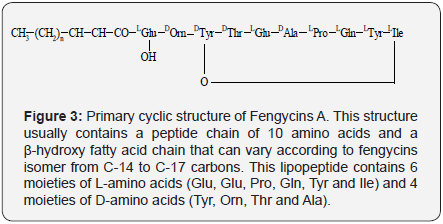
These bioactive molecules are lipopeptides containing lactose ring in the β-Hydroxy fatty acid chain that may be saturated or unsaturated. The structure of Fengycins contains a peptide chain of 10 amino acids linked to a fatty acid chain [27]. The length of the fatty acid chain can vary from C14 to C17 carbon atoms for Fengycins thus giving different homologous compounds and isomers. Fengycins are cyclic decapeptide formed by lactonization. The peptide portion of Fengycins lipopeptide consists of a decapeptide chain (Figure 3), which is made up of 8 amino acids (Tyr, Thr, Glu, Ala, Pro, Gln, Tyr and Ile) that are involved in the formation of a peptide ring via lactose linkage between side chain phenolic -OH group of Tyr3 and C-terminal -COOH group of Ile10 [28]. Members of Fengycins family exhibit heterogeneity at 6th position in peptide moiety as well as in chain length of ß-Hydroxy fatty acid, which varies from C14 to C17 carbons. On the basis of variation at single amino acid at 6th position in peptide ring, Fengycins have been classified in two classes’ viz. Fengycins A and Fengycins B. Fengycins A contains Ala at position 6 which is replaced by Val in case of Fengycins B.
Polymyxins: Polymyxinfamily of lipopeptides contains 10 amino acids with a content of the non-proteinogenic amino acid 2,4-diamino butyric acid. Usually, seven amino acids form a peptide cycle and a fatty acid is fused to the C-terminus of the three exocyclic amino acids. Six-methyl-octanoic acid or 6methyl-heptanoic acid can be found as lipid side chain moiety. Two representatives, Polymyxin B(i.e. amix of Polymyxin B1 and B2)and Polymyxin E (i.e. a mix of Polymyxin E1 and E2 ) obtained from B. polymyxa and B. colistinus) respectively, are already in clinical use. Polymyxins show little activity against Gram-positive and anaerobic bacteria but are potent bactericidal activity towards many Gram-negative bacteria including clinically relevant Pseudomonads, Enterobacteria and Acinetobacterspecies [29]. This can be explained by their mode of action, which involves a specific interaction of the penta-cationic peptide ring with lipopolysaccharide (LPS) of the anionic outer membrane, a target structure which exists solely in Gramnegative bacteria. By binding to LPS, Polymyxins competitively displace calcium and magnesium bridges which stabilize the outer leaflet of the outer membrane [30].
Applications of LPs
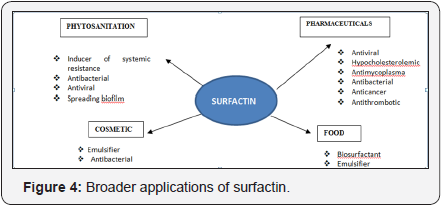
Antitumor activity and induction of apoptosis by ROS/ JNK pathway by the surfactin: Surfactins is an important bacterial lipopeptide considered as a versatile molecule with wider applications. Surfactins has been reported to show anticancer activity against Ehrlich’s as cites carcinoma cells. The effect of Surfactins as cytotoxic agent to the proliferation of a human colon cancer cell lines such as HCT-15 and HT29 [31] has also been reported. The transformed cells inhibition by Surfactins was due to the cell-cycle arrest and apoptosis induction via the suppression of cell survival signalling proteins such as ERK and PI3K/Akt [32]. The percentage of viable cells decreased with increasing concentrations and exposure time of Surfactins that indicated its cytostatic/cytotoxic effect against breast cancer cell lines like T47D and MDA-MB-231 [33].
Another study revealed that Surfactins lipopeptide inhibits proliferation and induces apoptosis of human breast MCF- 7 cancer cells trough a ROS/JNK-mediated caspase pathway (Figure 5) in a dose-dependent manner [34]. Surfactins generates the reactive oxygen species (ROS), which further activate the mediator of survival and JNK and ERK1/2, which are the key regulating elements in the apoptosis process. This showed that the action of Surfactins seems to be realized via two independent signalling mechanisms. The induction of apoptotic cell death is an emerging strategy for the prevention as well as treatment of cancer.
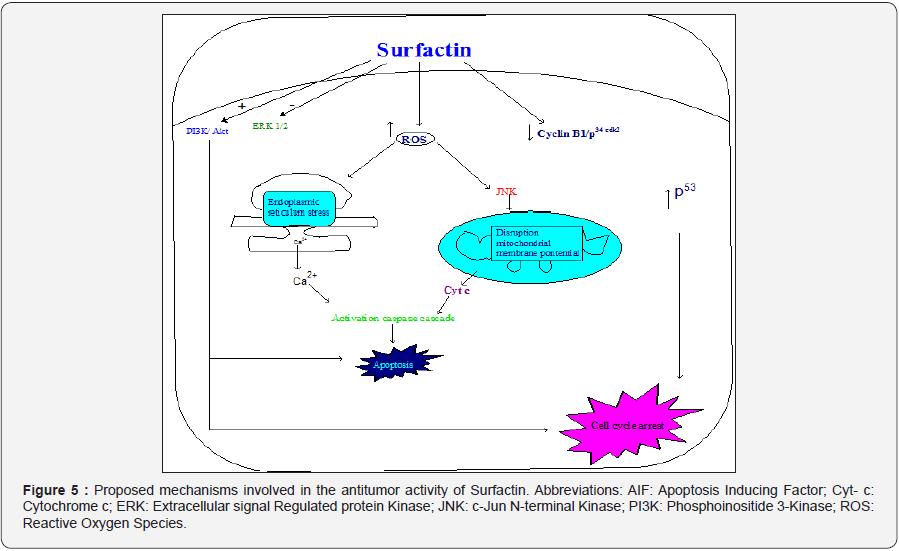
LPs induced apoptosis pathway: Oxidative stress induced by the LPs leads to the production of ROS in LPs-treated cancer cells. This oxidative stress in the cells further resulted in induction of apoptotic pathway in the cell, as evident by the fragmentation/ condensation of nuclei. Another marker for apoptotic cell death is DNA nicking, which is indicated by FACS-based TUNEL assay. Ample nicking of DNA depends on the concentration of the lipopeptide(s). However, surprisingly, caspase-3 band could not be detected using biotin-conjugated polyclonal rabbit anti active human caspase-3 antibody. PARP- 1 is a key nuclear enzyme that regulates transcription under homeostatic conditions while during in stress conditions, it responds to DNA damage and facilitates DNA repair [35]. In caspase independent death processes, some scientists have shown that PARP-1 plays an important role of initiator, activation of which is caused by DNA damage [36]. Many agents that cause DNA damage lead to PARP-1 activation.
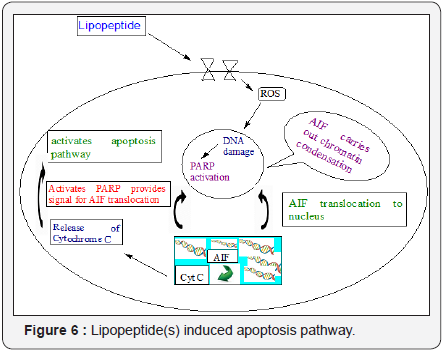
Some of these agents include H2O2, DNA alkylation agent N-methyl-N O-nitro-N-nitrosoguanidine (MNNG) and a neurotoxin 1-methyl-4-phenyl-1, 2, 3, 6-tetrahydropyridine (MPTP). Most of these agents generate ROS that lead to DNA damage. It is reported that oxidative stress/ROS lead to activation of both PARP-1 and AIF. In one of the pathways researchers have shown that imprudent activation of PARP-1 leads to an intrinsic caspase independent cell death program, in which PAR polymer appears to be a signaling molecule of death (Figure 6) that acts as a nuclear/mitochondrial signal to release AIF from the mitochondria of the cell [37].
Once released, AIF molecule translocated to the cytoplasm followed by nucleus, where it induces chromatin condensation. Subsequent to its own expulsion from mitochondria, AIF also triggers release of mitochondrial cytochrome c and caspase activation. In one of the experiments with cell-free systems, incubation of isolated HeLa nuclei with recombinant AIF resulted in peripheral chromatin condensation and DNA loss associated with high molecular weight (50kb) DNA fragmentation. AIF released from mitochondria and subsequent cell death was shown to be triggered by excessive calcium influx resulting in over activation of poly (ADP-ribose) polymerase-1. The normal cell division may be altered by some mutagenic event leading to onset of cancer/ tumor growth and proliferation (Figure 7).
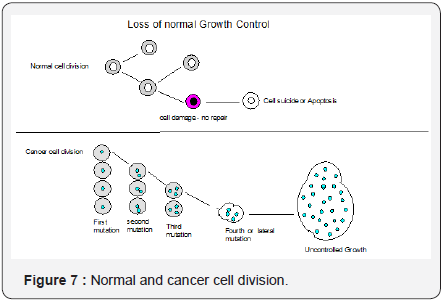
Lipopeptides in laundry and enhanced oil recovery: Cyclic LPs are stable and compatible to use as laundry detergents. Kiran et al. [38] found a new LP bio surfactant produced from strain B. aureum [2]. The bio surfactant produced can be employed successfully in enhanced oil recovery process in marine environments. LP from E. fergusonii KLU01 that was not sensitive to manganese, irons, lead, nickel, copper and zincs [38]. So, this bio surfactant possessed a potential in hydrocarbon degradation and heavy metal bioremediation. The extracellular LP produced from entophytic B. subtilis K1 which was taken from aerial parts of the banyan tree. The strain had high heterogeneity with secreted mixtures of Surfactins, Iturins and Fengycins. The lipopeptide resulted in about 43% enhanced oil recovery on a laboratory scale in the sand-packed column with four stroke engine oil. Suwat Soonglerdsongpha isolated a LP bio surfactant from Bacillus sp. GY19. The result implied that ~1-3% lipopeptide solutions had 80-100% efficiency of oil displacement with Oman light oil, heavy oil, diesel oil and Arabian light oil. In addition, the LP preparations were stable at extreme salinity, pH and temperature. Consequently, formate and powder containing LPs could be used directly as dispersants for oil spill remediation. LP bio surfactant produced from, a propitious bacterial E. fergusonii KLU01strain isolated from oil contaminated soil [39]. The strain emerges as a new class of bio surfactant lipopeptide producer with potential environmental and industrial applications, especially in hydrocarbon degradation and heavy metal bioremediation.
Anti obesity activity of the lipopeptides: Obesity is considered as a life style disorder especially in developing countries. It is prevailing mainly in new world countries due to fast food intake, including high fructose corn syrup added products consumption and lack of physical activity [40]. Pancreatic lipase inhibitory activity of the bioactive molecules has been largely used for the exploration of potential effectiveness of natural products. Lipopeptides bio surfactants have recently emerged as key molecules owing to their structural novelty, versatility and diverse properties that are potentially useful for advanced therapeutic applications [41]. Bacillus subtilis SPB1 lipopeptide can be a major drug of future to treat the obesity related metabolic disorders. B. subtilis lipopeptides can be administered orally, in order to achieve an effective control on body weight [42]. Bacillus subtilis SPB1 crude lipopeptide bio surfactant has a protective and a curative action on obese persons and it reduces the body weight of obese rats and treats hyperlipidemia without apparent side effects. Bacillus subtilis LPs reduced the body weight of mouse by reducing the serum pancreatic lipase activity [42].
Conclusion
The lipopeptides are relatively small sized lipidic-peptides of 1.1 to 1.2kDa size mainly synthesized by many Bacillus species. Being of bacterial origin, they also fulfil the criteria of an antibiotic. The LPs are categorised in three main types, i.e. Surfactins, Iturins and Fengycins besides Polymyxins. The Surfactant has strong surfactant properties besides high resistance to heat, cold and satiric influences. Turin A is an amphiphilic cyclic peptide which also exhibits antifungal activity. It is produced by several strains of Bacillus subtilis and is being exploited in food, oil and pharmaceutical industries The Fengycins has strong antifungal activity against filamentous fungi. Besides antibiotic applications, the LPs may be used in enhanced oil recovery, killing of cancer/tumour cells and its possible application in loss of fat cells allowing anti-obesity treatment. Interestingly, the bacterial lipopeptides have lower toxicity for plants and animals, high biodegradability, tissue compatibility and low irritancy.
Acknowledgement
This work has been funded by Department of Biotechnology, Ministry of Science and Technology, New Delhi under a DBTJRF Fellowship grant awarded to one of the authors (KRM) vide a Letter No. DBT-JRF/2011-12/270. The authors are thankful to Department of Biotechnology, Ministry of Science and Technology, New Delhi and Department of Biotechnology, Himachal Pradesh University, Shimla for the financial support for this work.
References
- Desai JD, Banat IM (1997) Microbial production of surfactants and their commercial potentials. Microbiol Mol Biol Rev 61: 47-64.
- Mukherjee AK (2007) Potential application of cyclic lipopeptide bio surfactants produced by Bacillus subtilis strains in laundry detergent formulations. Lett Appl Microbiol 45(3): 330-335.
- Meena KR, Saha D, Kumar R (2014) Isolation and partial characterization of Iturin like lipopeptides (a bio-control agent) from a Bacillus subtilis strain. Int J CurrMicrobiol Appl Sci 3(10): 121-126.
- Sujata SJ, Sanket JJ, Geetha SJ (2016) Lipopeptide production by Bacillus subtilis R1 and its possible applications. Brazilian Journal of Microbiology 47(4): 955-964.
- Meena KR, Kanwar SS (2015) Lipopeptides as the antifungal and antibacterial agents: Applications in food safety and therapeutics. Biomed Int J 2015: 1-6.
- Meena KR, Dhiman R, Sharma A, Kanwar SS (2016) Applications of lipopeptide(s) from a Bacillus sp: An overview. Res J Recent Sci 5(11): 50-54.
- Blanca HL, Chia-Chien H, Cristina MV (2017) Food bioactive compounds against diseases of the 21st century 2016. Biomed Res Int 2017: 1-2.
- Sergeev IN (2005) Calcium signaling in cancer and vitamin D. J Steroid Biochem Mol Biol 97(1-2): 145-151.
- Mandal SM, Barbosa AEAD, Franco OL (2013) Lipopeptides in microbial infection control: Scope and reality for industry. Biotechnol Adv 31(2): 338-345.
- Dhiman R, Meena KR, Sharma A, Kanwar SS (2016) Bio surfactants and their screening methods. Res J Recent Sci 5(10): 1-6.
- Ongena M, Jacques P (2008) Bacillus lipopeptides: versatile weapons for plant disease biocontrol. Trends Microbiol 16(3): 115-125.
- Deris ZZ, Swarbrick JD, Roberts KD, Azad MAK, Akter J, et al. (2014) Probing the penetration of antimicrobial polymyxin lipopeptides into gram-negative bacteria. Bioconjugate Chemistry 25(4): 750-760.
- Cao XH, Wang AH, Wang CL (2010) Surfactin induces apoptosis in human breast cancer MCF-7 cells through a ROS/JNK-mediated mitochondrial/caspase pathway. Chem BiolInteract 183(3): 357-362.
- Abdel-Mawgoud AM, Aboulwafa MM, Hassouna NAH (2008) Characterization of surfactin produced by Bacillus subtilis isolates BS5. Appl Biochem Biotechnol 150(3): 289-303.
- Mulligan CN (2009) Recent advances in the environmental applications of bio surfactants. Curr Opin Colloid Interface Sci 14(5): 372-378.
- Cameotra SS, Makkar RS (2004) Recent applications of bio surfactants as biological and immunological molecules. Curr Opin Microbiol 7(3): 262-266.
- Yan Z, Qun W, Yan X (2017) Genome and transcriptome analysis of surfactin biosynthesis in Bacillus amyloliquefaciens MT45. Sci Rep 7: 40976.
- Hathout Y, Ho YP, Ryzhov V, Demirev P, Fenselau C (2000) Kurstakins: a new class of lipopeptides isolated from Bacillus thuringiensis. J NatProd 63(11): 1492-1496.
- Kim PI, Ryu J, Kim YH, Chi YT (2010) Production of bio surfactant lipopeptides iturin A, fengycin, and surfactin A from Bacillus subtilis CMB32 for control of Colletotrichum gloeosporioides. J Microbiol Biotechnol 20(1): 138-145.
- Aranda FJ, Teruel JA, Ortiz A (2005) Further aspects on the hemolytic activity of the antibiotic lipopeptide iturin A. Biochimica et Biophysica Acta 1713(1): 51-56.
- Tsuge K, Akiyama T, Shoda M (2001) Cloning sequencing and characterization of the iturin A operon. J Bacteriol 183(21): 6265- 6273.
- Seydlová G, Čabala R, Svobodová J (2011) Biomedical engineering, trends and research and technologies. Surfactin - novel solutions for global issues. INTECH 13: 306-330.
- Korenblum E, Araujo LV, Guimarães CR, Souza LM, Sassaki G, et al. (2012) Purification and characterization of a surfactin-like molecule produced by Bacillus sp. H2O-1 and its antagonistic effect against sulfate reducing bacteria. BMC Microbiol 12: 252.
- Zou A, Liu J, Garamus VM, Yang Y, Willumeit R, et al. (2010) Micellization activity of the natural lipopeptide [Glu1, Asp5] surfactin-C15 in aqueous solution. J Phys Chem B 114(8): 2712-2718.
- Tsan P, Volpon L, Besson F, Lancelin JM (2007) Structure and dynamics of surfactin studied by NMR in micellar media. J Am Chem Soc 129(7): 1968-1977.
- Deleu M, Paquot M, Nylander T (2008) Effect of fengycin, a lipopeptide produced by Bacillus subtilis, on model biomembranes. Biophys J 94(7): 2667- 2679.
- Akpa E, Jacques P, Wathelet B, paquot M, fuchs R, et al. (2001) Influence of culture conditions on lipopeptide Production by Bacillus subtilis. Appl Biochem Biotechnol 91: 551-561.
- Pathak H, Bhatnagar K, Jaroli P (2012) Serratia-The 4T engine oil degrader. Sci Rep 1: 117.
- Landman D, Georgescu C, Martin DA, Quale J (2008) Polymyxins revisited. Clin Microbiol Rev 21(3): 449-465.
- Hermsen ED, Sullivan CJ, Rotschafer JC (2003) Polymyxins: pharmacology, phar- macokinetics, pharmacodynamics, and clinical applications. Infect Dis Clin North Am 17(3): 545-562.
- Sivapathasekaran C, Das P, Mukherjee S, Saravanakumar J, Mandal M, et al. (2010) Marine bacterium derived lipopeptides: Characterization and cytotoxic activity against cancer cell lines. Int J Pept Res Ther 16(4): 215-222.
- Kim SY, Kim JY, Kim SH, Bae HJ, Yi H, et al. (2007) Surfactin from Bacillus subtilis displays antiproliferative effect via apoptosis induction, cell cycle arrest and survival signaling suppression. FEBS Lett 581(5): 865- 871.
- Duarte C, Gudina EJ, Lima CF, Rodrigues LR (2014) Effects of bio surfactants on the viability and proliferation of human breast cancer cells. AMB Express 4: 40.
- Lee JH, Nam SH, Seo WT, Yun HD, Hong SY, et al. (2012) The production of Surfactin during the fermentation of Cheonggukjang by potential probiotic Bacillus subtilis CSY191 and the resultant growth suppression of MCF-7 human breast cancer cells. Food Chem 131(4): 1347-1354.
- Yu SW, Wang H, Poitras MF, Coombs C, Bowers WJ, et al. (2002) Mediation of poly (ADP-ribose) polymerase- 1-dependent cell death by apoptosis-inducing factor. Science 297(5579): 259-263.
- Alonso M, Tamasdan C, Miller DC, Newcomb EW (2003) Flavopiridol induces apoptosis in glioma cell lines independent of retinoblastoma and p53 tumor suppressor pathway alterations by a caspaseindependent pathway. Mol Cancer Ther 2(2): 139-150.
- Yu SW, Andrabi SA, Wang H, Kim NS, Poirier GG, et al. (2006) Apoptosisinducing factor mediates poly (ADP-ribose) (PAR) polymer-induced cell death. Proc Natl Acad Sci USA 103(48): 18314-18319.
- Kiran G, Thomas AT, Selvin J, Sabarathnam B (2010) Optimization and characterization of a new lipopeptide bio surfactant produced by marine Brevibacterium aureum MSA13 in solid state culture. Bioresour Technol 101(7): 2389-2396.
- Nichakorn K, Sitti T, Onruthai P, Rudolf M, Soonglerdsongpha S, et al. (2015) Lipopeptide bio surfactant production by chitosan-immobilized Bacillus sp. GY19 and their recovery by foam fractionation. Biochem Eng J 93: 47-54.
- Bray GA (2013) Energy and fructose from beverages sweetened with sugar or high- fructose corn syrup pose a health risk for some people. Adv Nutr 4: 220-225.
- Gudina EJ, Rangarajan V, Sen R, Rodrigues LR (2013) Potential therapeutic applications of bio surfactants. Trends Pharmacol Sci 34(12): 667-675.
- Zouari R, Hamden K, Feki AE, Chaabouni K, Makni-Ayadi F, et al. (2016) Protective and curative effects of Bacillus subtilis SPB1 bio surfactant on high-fat-high-fructose diet induced hyperlipidemia, hypertriglyceridemia and deterioration of liver function in rats. Biomed Pharmacother 84: 323-329.






























